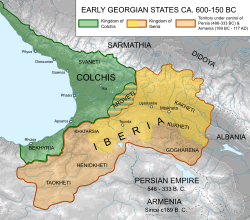
Back Koninkryk Iberië AF Iberie Cynerīce ANG مملكة إيبيريا Arabic مملكة ايبيريا ARZ Reinu d'Iberia AST İberiya çarlığı AZ ایبریا شاهلیغی AZB Иберия (батшалыҡ) BA Іберыя (царства) BE Иверия Bulgarian
Kingdom of Iberia ქართლის სამეფო kartlis samepo | |||||||
|---|---|---|---|---|---|---|---|
| c. 302 BC – 580 AD | |||||||
 Colchis and Iberia | |||||||
| Status |
(302–159 BC)
(65–63 BC, 40–36 BC, 30–1 AD)
(1–129 AD, 131–260 AD)
(260–265 AD)[5]
(298–363 AD)
(363–482 AD, 502–523 AD)
(523–580 AD)
(580–588 AD) | ||||||
| Capital | |||||||
| Common languages | Greek–Aramaic (language of governance, literacy and culture)[7] Old Georgian (literacy and native language)[8] | ||||||
| Religion | Georgian paganism[9] Zoroastrianism[10] Christianity (from 319)[11] | ||||||
| Government | Monarchy | ||||||
| Historical era | Antiquity | ||||||
• Reign of Pharnavaz I | c. 302 BC | ||||||
• Christianization of Iberia during reign of Mirian III | 317 AD[12] | ||||||
• Direct Sasanian control and abolition of the monarchy | 580 AD | ||||||
| |||||||
| Part of a series on the |
| History of Georgia |
|---|
 |
In Greco-Roman geography, Iberia (Ancient Greek: Ἰβηρία Iberia; Latin: Hiberia; Parthian: wurğān; Middle Persian: wiručān) was an exonym for the Georgian kingdom of Kartli (Georgian: ქართლი), known after its core province, which during Classical Antiquity and the Early Middle Ages was a monarchy in the Caucasus, either as an independent state or as a dependent of larger empires, notably the Sassanid and Roman empires.[13] Iberia, centered on present-day Eastern Georgia, was bordered by Colchis in the west, Caucasian Albania in the east and Armenia in the south.
Its population, the Iberians, formed the nucleus of the Kartvelians (i.e. Georgians). Iberia, ruled by the Pharnavazid, Artaxiad, Arsacid and Chosroid royal dynasties, together with Colchis to its west, would form the nucleus of the unified medieval Kingdom of Georgia under the Bagrationi dynasty.[14][15]
In the 4th century, after the Christianization of Iberia by Saint Nino during the reign of King Mirian III, Christianity was made the state religion of the kingdom. Starting in the early 6th century AD, the kingdom's position as a Sassanian vassal state was changed into direct Persian rule. In 580, king Hormizd IV (578–590) abolished the monarchy after the death of King Bakur III, and Iberia became a Persian province ruled by a marzpan (governor).
The term "Caucasian Iberia" is also used to distinguish it from the Iberian Peninsula in Southwestern Europe.[16]
- ^ Rayfield, Donald (2012). Edge of Empires: A History of Georgia. pp. 26, 29, 417.
- ^ Ronald Grigor Suny. The Making of the Georgian Nation. p. 15.
- ^ Rayfield, Donald (2012). Edge of Empires: A History of Georgia. pp. 29–35.
- ^ Braund pp.233–237
- ^ Rayfield, Donald (2012). Edge of Empires: A History of Georgia. pp. 35–36.
- ^ Rayfield, Donald (2012). Edge of Empires: A History of Georgia. p. 38.
- ^ A. Furtwängler, I. Gagoshidze, H. Löhr and N. Ludwig(2008) - Iberia and Rome. Page - 25-26
- ^ History of Georgia 2012, p. 165.
- ^ (in Georgian) Javakhishvili, Ivane (1982), k'art'veli eris istoria (The History of the Georgian Nation), vol. 1, p. 51. Tbilisi State University Press.
- ^ Georgian Soviet Encyclopedia (1997), v. 4, p. 537—538
- ^ Rapp, Stephen H., Jr (2007). "7 - Georgian Christianity". The Blackwell Companion to Eastern Christianity. John Wiley & Sons. p. 138. ISBN 978-1-4443-3361-9. Retrieved 10 December 2024.
- ^ Rayfield, Donald (2012). Edge of Empires: A History of Georgia. p. 39.
The year 317 is the only one that century when a total eclipse of the sun was visible at Mtskheta. To convert before the Council of Nicaea in 325.
- ^ Ehsan Yarshater (1983). The Cambridge History of Iran: The Seleucid, Parthian, and Sasanian periods. Cambridge University Press. pp. 520–. ISBN 978-0-521-20092-9. Retrieved 18 September 2013.
- ^ Ronald Grigor Suny. The Making of the Georgian Nation. Indiana University Press, p. 13 ISBN 0-253-20915-3.
- ^ William Coffman McDermott, Wallace Everett Caldwell. Readings in the History of the Ancient World. p. 404.
- ^ Mikaberidze, p. 360
